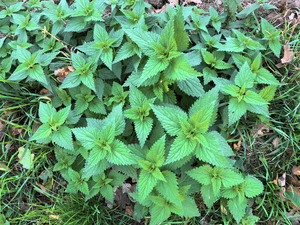Urtica facts for kids
Quick facts for kids Urtica |
|
|---|---|
 |
|
| Scientific classification |
Urtica is a group of plants often called nettles. You might know them because they can make your skin itch if you touch them! The most famous one is Urtica dioica, which is commonly known as the stinging nettle. Nettles are found all over the world, especially in places with a mild climate. They are known for their unique stinging hairs.
Contents
What Are Nettles?
Nettles are flowering plants that belong to the Urticaceae family. They are known for their green leaves and small, often greenish flowers. What makes them special are the tiny, hollow hairs on their stems and leaves. These hairs are called trichomes.
Why Do Nettles Sting?
When you brush against a nettle, the tips of these tiny hairs break off. This creates a sharp, needle-like point. These broken hairs then act like tiny syringes. They inject chemicals into your skin. The main chemicals are:
- Histamine
- Acetylcholine
- Serotonin
- Formic acid (the same acid found in ant stings!)
These chemicals cause the stinging, burning, and itching feeling you get. It's the plant's way of protecting itself from animals that might want to eat it.
Where Do Nettles Grow?
Nettles are very common plants. They can grow in many different places around the world. You can often find them in:
- Gardens
- Forests
- Fields
- Along roadsides
- Near rivers and streams
They like soil that is rich in nutrients, especially nitrogen. This is why they often grow in places where the soil has been disturbed.
Types of Nettles
There are about 30 to 40 different kinds of nettles in the Urtica group. Here are a few well-known ones:
- Stinging Nettle (Urtica dioica): This is the most common type. It can grow quite tall, sometimes over 6 feet (2 meters). It has heart-shaped leaves and is found in many parts of the world.
- Annual Nettle (Urtica urens): This nettle is smaller than the stinging nettle. It usually lives for only one growing season. It also has a strong sting.
- Roman Nettle (Urtica pilulifera): This type is less common. It has rounder clusters of flowers.
Life Cycle and Reproduction
Nettles can reproduce in a few ways. They can spread using seeds, which are carried by wind or animals. They also have underground stems called rhizomes. These rhizomes can spread out and grow new plants. This is why nettles can often form large patches.
Flowers and Seeds
Nettle plants have small flowers that are often green or brownish. Some nettle plants have only male flowers, and others have only female flowers. The wind carries pollen from the male flowers to the female flowers. After the female flowers are pollinated, they produce tiny seeds. These seeds can then grow into new nettle plants.
Uses of Nettles
Even though nettles sting, they have been used by people for thousands of years! They are surprisingly useful plants.
Food and Drink
When nettles are cooked, their stinging hairs become harmless. They are very nutritious and are full of vitamins and minerals. People use nettles to make:
- Soups
- Teas
- Pesto
- Even beer!
They taste a bit like spinach when cooked.
Medicine and Health
For a long time, nettles have been used in traditional medicine. People believed they could help with many health issues. Today, some studies are looking into their possible benefits for:
- Reducing swelling
- Helping with allergies
- Supporting joint health
However, it's important to remember that you should always talk to a doctor before using plants for medicine.
Other Uses
Nettles have also been used for other interesting things:
- Fibers: The stems of nettles contain strong fibers. These fibers have been used to make cloth, paper, and ropes, similar to flax or hemp.
- Dye: The plant can be used to make green or yellow dyes for fabrics.
- Fertilizer: Nettle plants can be made into a liquid fertilizer for other plants in a garden.
What to Do If You Get Stung
If you accidentally touch a nettle and get stung, don't worry! The sting usually goes away after a few minutes or hours. Here's what you can do:
- Don't touch or rub: Try not to rub the area right away. This can push the stinging hairs deeper into your skin.
- Use tape: You can try using sticky tape to gently pull off any remaining hairs.
- Wash the area: Once the initial sting has lessened, wash the area with soap and water.
- Cool compress: A cool, damp cloth can help soothe the itching and burning.
- Natural remedies: Some people find relief by rubbing the sap from plants like dock leaves or jewelweed on the sting. These plants often grow near nettles!
Images for kids
See also
 In Spanish: Ortiga para niños
In Spanish: Ortiga para niños


